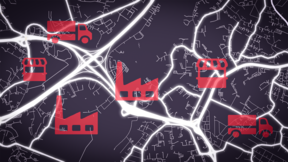Fast communications and flexibility helped grocery retailers cope with the coronavirus in spring

A team of Aalto University researchers led by Assistant Professor Lauri Saarinen studied grocery supply chains during the coronavirus crisis, and the shocks that the crisis inflicted on supply and demand. The first interviews were conducted in real time, very soon after the onset of the crisis, and after the first government decisions were being made.
Potential threats recognised by the researchers in advance included reduction in the supply, customers hoarding of goods, an inability of manufacturers to react quickly and effectively, and the bullwhip effect, where there is excessive manufacture of some products arising from the incorrect decision-making. Initial results indicated that switching to daily planning and communications among different companies in the supply chain helped avert these threats, and that pre-existing forecast models and proactive procedures based on history lost their significance under the exceptional conditions. The results can help in preparing for a possible second wave of the coronavirus.
‘The crisis in commerce and hoarding by consumers began with the government's first press conference. Hoarding was limited to just a few days because detailed communications from the government, and fast deliveries convinced consumers that the availability of products would remain good. Production also successfully targeted the right products’, Lauri Saarinen says.
The best actors shifted to daily planning
If the availability of products had not been restored fairly quickly, hoarding would have increased, newspapers would have had more pictures of empty shelves in stores, which would have brought a massive rush of people into the stores.
The most important findings concerned communications, agile planning, resources, and procedures.
‘In exceptional times daily communication of the most critical matters is important. For example, if demand for bread increases fivefold, we need to find out how to maximize the production of bread and to distribute it to the stores as even-handedly as possible’, Lauri Saarinen says.
Normally, shops steer supply and production through their orders, and plans are made at the weekly or monthly level. During the coronavirus first wave the best performing companies adopted daily planning. Manufacturers told the retailers and suppliers what they can produce at each specific time and the merchants told the manufacturers what goods they need more of.
‘Planning was based on up-to-date information, considering the most important bottlenecks and goals, while maximising availability’, Saarinen says.
Forecasting and long term data sharing were less significant in the coronavirus crisis. Instead, planning, reacting and fast adaptability to the new situation were more important.
‘Coping with the crisis required flexible and versatile resources and procedures. Sales data loses its significance if a store runs out of goods. Local manufacturers of perishable goods are used to acting with agility and according to rapid seasonal change, but for other businesses the new operating model required a reorganisation of resources to cope with the bottlenecks’, Saarinen explains.
The last interviews for the newly published report were conducted in early June, and at that point the situation had not yet returned to what it was before the crisis. For example, products linked with home cooking still sell better than they did before the crisis, but the “bullwhip effect” has been successfully kept to a minimum.
‘When there is change in the consumer interface, there is usually a move to make predictions and to manufacture more products to avert shortages. When the demand shock moves up the supply chain, massive amounts of goods are sometimes manufactured beyond the actual need. Finally, warehouses can be full of products that nobody wants to buy. During the coronavirus period the wrong kind of efficiency thinking, and forecasting were rejected, and goods were manufactured quickly and flexibly according to the needs of commerce’, Lauri Saarinen explains.
For the study, food businesses in Finland were interviewed at all levels of the production chain, from sales, to logistics, to the manufacturers. There was a need to ascertain how companies would react together to the extensive shock in supply and demand that the coronavirus had caused. Data indicates that the situation looked similar internationally, in Germany and Italy, for example. An initial report has been published on the study based on the findings of the spring, and the study will be expanded in the autumn of 2020.
Further information:
Preliminary report of the study: https://aaltodoc.aalto.fi/bitstream/handle/123456789/45356/isbn9789526039602.pdf?sequence=3&isAllowed=y
Read more news

Your voice gives away valuable personal information, so how do you keep that data safe?
With speech technologies becoming increasingly common, researchers want to make sure we don’t give away more information than we mean to.
A new way to measure contagion: the gut bacterium behind blood poisoning can spread like influenza
Neither the antibiotic-resistant nor the highly virulent strains are the most transmissible.
Cross-sectoral working group: Competitiveness, security and green transition must be promoted as a whole
A cross-sectoral working group for universities, businesses and cities is proposing that Finland speed up its international competitiveness, national security and green transition as one entity. The group suggests that, for example, defence procurement could support solutions aimed at a carbon-neutral society.






